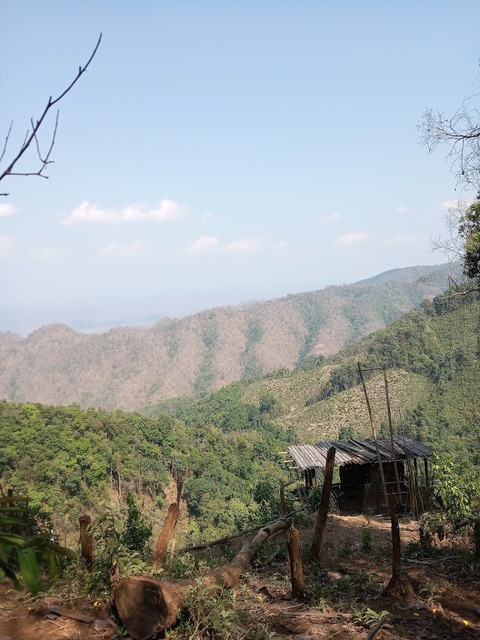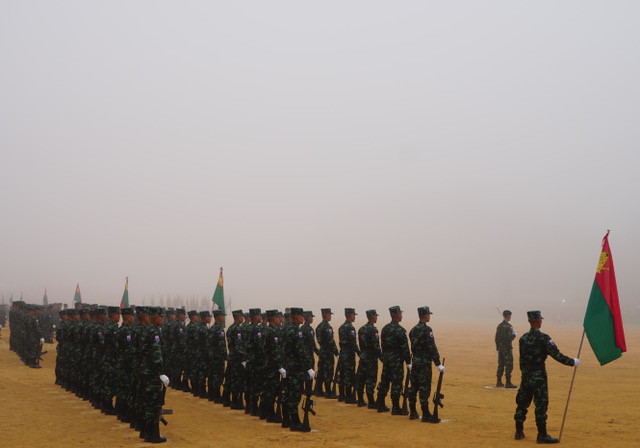In what ways can we better understand the benefits of foregrounding ethnography as a practice with shifting points of attention, a moving terrain in which our work both literally and theoretically shifts as we engage in long-term fieldwork? Ethnographers have long remarked on the tensions of maintaining bounded objects while remaining open to new questions and avenues of research. How could one not, when anthropologists study the changing relations at the heart of human life? Highlighting research and conceptual challenges faced in recently completed fieldwork in an upland autonomous area in Southeastern Burma (Myanmar), I hope to offer a brief example of how a structured yet flexible research design, so often absent in a world of rigid research frameworks, measured outputs and research analytics, not only has the potential to offer unique insights but has profound implications for research outcomes and our understanding of the kinds of relations we foreground as important in peoples’ lives, writes Dominique Dillabough-Lefebvre.
_______________________________________________
Shifting Relations in Context
In the Mutraw (Hpapun) Hills, an autonomously governed territory in Southeastern Myanmar lying along the Thai border, local peoples have long practiced swidden (or shifting) agriculture. This practice involves clearing and burning new patches of land every year. In the process, this creates moving farms, shifting forest gardens, and re-settles villages. As villagers increasingly adopt new methods of house construction – employing wood rather than the traditionally employed bamboo homes – these once shifting villages became more ‘settled’, with the areas of Swidden cultivation now rotating around more ‘settled’ villages on the slopes of these undulating hills. These hills are home to the Karen National Union’s Brigade 5, laying claim to an area with the largest contiguous territory of the Karen “liberated areas”. Here, the armed wing of the organisation, the Karen National Liberation Army (KNLA), has held on to large swathes of land, employing forms of guerrilla warfare and, in turn, depending on the mobility of its troops and their extensive knowledge of the terrain. When fighting flared up between the KNLA and the Sit-Tat (also known as the Tatmadaw or Burmese State Military), local farmers were forced to flee their villages, tragically returning to more mobile forms of living. At present, tens of thousands of villagers in these areas are leaving their homes at night to sleep in forests, fearing the airstrikes of the Sit-Tat who are increasingly weak on the ground and thus adopting more aggressive tactics to fight its wars against its ‘internal enemies’. Being adept at shifting terrain is key to the survival of those living in these hills.

Flexible points of Attention in Research Practice
I arrived in Southeastern Myanmar’s Mutraw (Hpapun) hills in December 2019 to attend the opening ceremony of the Salween Peace Park. This project, spearheaded by a local civil society group known as the Karen Environmental Social Action Network (KESAN), has since been extensively internationally lauded through the awards of the 2020 Equator Prize and 2020 Goldman Environmental Prize for Asia. The project was proposed as a bottom-up participatory process to be developed in conversation with local peoples, who call themselves Pya K’naw or S’gaw Karen, and the local administration, the Karen National Union (KNU). This initiative gained a flurry of attention, amongst environmental movements across Myanmar and worldwide as well as support from international NGOs, as an exemplary vision of indigenous-led conservation as well as a blueprint for local governance in line with principles of self-determination. All this in a context plagued by armed conflicts, ongoing since the end of the Second World War. For international actors as well as to the Burmese State, the Peace Park project enabled the translation and codification of local social practices, many of which are rooted in local animistic relationships to land, into a legible forms of governance. It both prefigured and made visible what the activists referred to as ‘customary practices’ or institutions, which these activists saw as necessary for the foundations of recognition for autonomy or statehood. In other words, to prove not only that they have a government, but also that the land has long been governed by customary laws and practices. This echoes calls of indigenous peoples worldwide, as well as amongst scholars of legal pluralism, to recognise a breadth of social practices as technically equivalent to legal frameworks and instructions, though not necessarily to be subsumed within rigid legalistic frameworks. Amidst this very publicly visible project, my research rather aimed to more broadly examine processes of agrarian change within the Mutraw Hills, whether or not this included the Peace Park. In particular, I was interested in how local smallholder farmers resisted rapidly accelerating processes of conflict, development-induced displacement and dispossession of land. While the Park clearly had a role to play in this process, I was interested in particular in the ways local smallholders experienced and dealt with displacement and dispossession. Yet, these points of attention shifted the longer I spent visiting and eventually living in the area, in ways I hope to show were productive.
Using land as a focal point for my research seemed evident, in an area where subsistence farmers formed the overwhelming majority of the population, and conflicts over territory appeared to be central to the grievances of local populations. Part of my interest in land also stemmed from the fact that the area was home to some of the largest remaining populations of Karen Molupala practitioners. Molupala is a term that encompasses a range of animist practices and traditions, some of which are focused on appeasing spirits of land and ancestors still present in the landscape. These spirits tend to exert strong moralistic judgement on the behaviour of living people, while certain spirits offer protection if certain terms and exchanges are maintained, such as rigid principles of monogamy. These animistic practices are currently undergoing revitalisation and codification as part of indigenous rights movements that have been advocating for territorial sovereignty for Karen peoples, precisely at the moment these practices appear to be disappearing. However, the longer I spent in the Mutraw area, the more certain preconceptions and projections of the area increasingly appeared potentially problematic from an ethnographic standpoint. While ethnographic selectivity is part of delimiting our frame, selective attention can conceal aspects of life critical to the social worlds we study. I increasingly noticed how the work of environmental advocates and civil society organisations had often dovetailed with academic work in the area. A series of excellent recent ethnographies on the area predominantly foregrounded animism (Cole 2020, Paul 2019), doing research in the areas with the highest concentration of animists. In the process, I saw that these works could have the potential to allow relations between humans to recede somewhat, and thus could be read as placing political economy as somehow less relevant than relations between humans and non-human beings (paradoxically as attempts are made to transcend these categories). In following potential slippages through prioritising certain forms of vision or ontologies, do ethnographers have the potential, through forms of activism or selective vision, to re-other that which we seek to find a common purpose? Do such portrayals reflect the way most people in the area experienced and managed relationships? Was the idea that the land was both governed by spirits and the KNU not contradictory, as the activists and some locals argued. Could the spirits and the armed leaders live in harmony? Ultimately, the longer I spent with people from these areas, the more the categories of Animist and Christian, of farmer and soldier, of environmentalist and nationalist seemed to recede. The true complexity and ethnographic richness arose from these same ambiguities and contradictions.
This brings us to the question of what to highlight? What frames, language and ways of relating are more important to local people? In what ways do the local spirits, the Christian God and the leaders of the local military organisation interrelate? What relationships, forms of exchange and values are most important to local people? As I understand the comparative anthropological project, the value of ethnography is precisely to shed light on these relationships in ways in which local people may not be able to convey and/or may be unable to voice. And, while these views may come into collaboration with the political aspirations of those we become close to, they may of course also diverge. Keeping this in mind, I turn to fragments that offers a glimpse of a shifting terrain.

Fragments
While living in this area, I stayed in two different schools. Here, daily life had a rhythm, almost monastic quality, somewhere between what I’d have imagined living in a boarding school or a military training camp and what a religious institution would have felt like. Given that the schools were founded by people raised in mission schools and that a sizeable portion of the students would go on to be students, forms of ‘pastoral power’ dominated daily life. Beyond a picture of a disciplinary and regimented daily life, there was of course much joy, freedom and pleasure. Days were long, often lonely and solitary yet evenings were most often filled with a communal warmth and spirit of hospitality unlike I have encountered anywhere else. I spent my spare time helping kids with English pronunciation, practicing Karen with the other teachers, and asking them endless questions about animist rituals they often only understood the lining of. In most cases, they were embarrassed to talk about such matters. It was as if these were remnants of a past that was itself taboo, that was to be selectively celebrated, but that was distinctively a mark of under-education.Some would at times say:“people used to believe” … while in hushed tones often adding “so many of the ‘Christians here are not real Christians”. Over time the tensions between how the self-representing Animists, Christians and activists portrayed relationships to land and my perceptions of the realities of day-to-day governance became increasingly stark. Animist spirits of land were increasingly cast as being banished by an all-powerful Christian God, while the Christian God’s powers were often overshadowed by that of the local military commanders in the KNU. And, what of land and displacement? What does this shifting terrain tell us about how people understand and deal with displacement, and the important forces they have relationships with?
Returning to the question of methodological openness, such examples of shifting points of attention can help shed light on why flexibility in research design can have significant effects on what we foreground in our research. The questions I hope to answer in my research, have, for example, increasingly shifted in focus to the interplay between agrarian traditions drawn from animism and the practices of Christianity in the region, predominantly as they are oriented towards land and belonging. Alongside this, militaristic relationships could also not be ignored while trying to understand forms of labour, power dynamics and peoples’ relationships to land and dynamics of displacement. Understanding such relations became essential in my research to understanding governance, ecological challenges, and social movements in an area long home to conflict. Ignoring these relations, or solely foregrounding others, appeared to mute many of the forms of living in common and living apart which form the outline for so much of social life in the region.
Maintaining a flexibility when conducting research, and an awareness of the importance of such openness, allows researchers cast their net wider. A breadth and playfulness in research, which inherently requires time, false starts and detours can thus allow for more productive engagement with our initial research questions, and in turn these questions may change to ends which may be radically different. Institutions and organisations conducting research should also allocate appropriate resources and allow bureaucratic procedures to be flexible towards such ends. A return to slower forms of attention, for example: ethnography, long form journalism, documentary film, prioritising local researchers and long term qualitative research may help us adapt to many of the rapidly shifting problems we currently face globally.

______________________________________________
*Banner photo by and copyright of the Author.
*Dominique’s research was supported by the LSE Saw Swee Hock Southeast Asia Centre PhD Research Support Fund.
*The views expressed in the blog are those of the author alone. They do not reflect the position of the Saw Swee Hock Southeast Asia Centre, nor that of the London School of Economics and Political Science.





